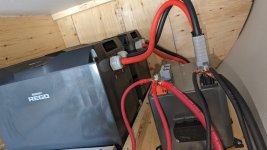Harvey The RV
Member
Last fall, we took delivery on a brand new 2024 North Trail 25RBP. We installed a bunch of extra gear (see below), and now we're looking into how to supply the air conditioner and the couple of electrical outlets that aren't already on the "pre-wired for solar" grid while we boondock, which we intend do do the majority of the time we're out.
Existing setup:
Everything that was upgraded so far, we never had to go behind any walls or the ceiling, nor work without the clear instructions of the things we were installing. We're no electricians.
So would anybody be so kind as to talk us through whatever else we have to do in order to have our air conditioner and remaining electrical outlets available while boondocking? Hopefully, some others among you know more than we do! 🤓
Thanks!
Existing setup:
- The North Trail itself plugs into 50 amp shore service and, as indicated above, it came pre-wired for solar (Sōl).
- On the roof, we installed and plugged in 6 x 200W solar panels.
- In the passthrough storage, which is now (mostly) our electrical bay, we attached large sections of plywood as the mounting surfaces for:
- 2 x 400Ah LiFePO4 batteries (800Ah total), attached to...
- A compatible battery combiner box, through...
- A 100A solar charge controller, with everything running through...
- A 3000W pure sine wave HF inverter charger, to...
- The house main breaker.
Everything that was upgraded so far, we never had to go behind any walls or the ceiling, nor work without the clear instructions of the things we were installing. We're no electricians.
So would anybody be so kind as to talk us through whatever else we have to do in order to have our air conditioner and remaining electrical outlets available while boondocking? Hopefully, some others among you know more than we do! 🤓
Thanks!
Attachments
-
 PXL_20240318_163833299.jpg996.6 KB · Views: 40
PXL_20240318_163833299.jpg996.6 KB · Views: 40 -
 PXL_20240318_163840079.jpg1.1 MB · Views: 31
PXL_20240318_163840079.jpg1.1 MB · Views: 31 -
 PXL_20240323_150849959.jpg1.8 MB · Views: 27
PXL_20240323_150849959.jpg1.8 MB · Views: 27 -
 PXL_20240323_150842381.jpg1.6 MB · Views: 25
PXL_20240323_150842381.jpg1.6 MB · Views: 25 -
 PXL_20240323_150829806.jpg1.8 MB · Views: 25
PXL_20240323_150829806.jpg1.8 MB · Views: 25 -
 PXL_20240323_150818976.jpg927.7 KB · Views: 25
PXL_20240323_150818976.jpg927.7 KB · Views: 25 -
 PXL_20240323_150809063.jpg1.8 MB · Views: 21
PXL_20240323_150809063.jpg1.8 MB · Views: 21 -
 PXL_20240323_150745060.jpg712.1 KB · Views: 34
PXL_20240323_150745060.jpg712.1 KB · Views: 34


